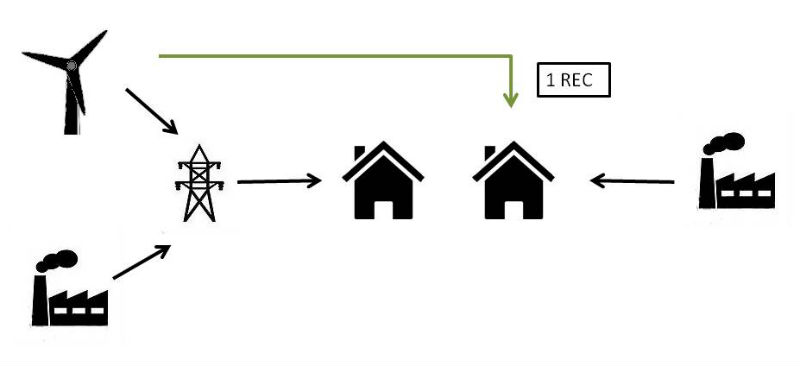Renewable Energy Credits
If you are looking into purchasing a green energy contract, you will likely come accross the word "REC" (Renewable Energy Certificates). But what are they, and how do they support green energy? Find out everything you need to know about REC and how they work.
What are Renewable Energy Certificates?
Renewable Energy Certificates (REC) are non-tangible energy commodities that represent the property rights to the environmental, social and other nonpower qualities of green (renewable) electricity generation, measured in units of one (1) Megawatt-hour. In other words, a REC represents the proof of one MWh of renewably-generated electricity. A REC (and its associated environmental benefits) can be sold separately from the physical electricity that it came from.
How Do REC Work?

- A renewable generation facility applies for an acquires certification by the local authority.
- Certified renewable electricity generation facilities are credited with one REC for every Megawatt-hour of elecricity they inject into the grid. These REC are issued by a certifying agency, and given a unique number that allows them to be tracked.
- The the physical electricity produced by the green electricity generation facility goes directly into the grid, at which point it can't be distinguished from conventionally-produced electricity. The associated REC can be sold separately on the open market.
- The price of the REC can depend on the type of renewable energy source and on its vintage
- The purchaser of a REC 'retires' it in order to claim the associated benefits. 'Retirement' means that the REC can no longer be bought and sold (and therefore can't be double-counted)
Renewable Energy Certificate Standards
Certification is an important aspect of the REC system. In order for it to be allowed to generate and sell REC, a renewable energy generation facility must be certified by a regulatory authority, ensuring that its electricity generation meets certain standards. The REC themselves are most often certified and tracked by a third party as well.
Renewable Energy Certificates vs. Renewable Energy
Purchasing a REC is not quite the same as purchasing the renewable energy itself. In fact, unless you are able to generate your own electricity, it is impossible to determine the precise source(s) of the electricity you use, as once electricity enters the grid it becomes indistinguishable. Furthermore, as REC are not necessarily tied to a particular geography, the REC that you purchase (or that are purchased and retired on your behalf by your green energy supplier) may not necessarily connected to the same electricity grid as the one into which the associated physical electricity was injected. However, by purchasing an REC, an electricity user can claim to have offset their carbon emissions.

Are All REC Equal?
All renewable energy certificates are not the same and in fact certificates provide information about the associated electricity, including:
- The type of renewable resource from which the electricity was produced (e.g. wind, solar, hydro, biomass, etc)
- The location of the renewable generation facility
- The REC's "vintage", (the date that the certificate was issued)
- The date when the renewable generator was built, and any associated GHG emissions with generation (if any)
Renewable energy certificates can range in price, depending on the location and type of renewable resource, with a "national renewable blend" product at the lowest cost, and REC associated with a specific technology or region gaining higher prices.
What to Look for in a Green Energy Contract
Green Percentage
As not all energy suppliers purchase REC as part of their green energy plans, it is first a good idea to check out what their definition of "green" is. If REC are part of the green energy plan, you should also check out what percentage of your energy consumption will be compensated by REC.
Locally Produced?
As REC are not bound by geography, you may also want to consider choosing a contract that allows you to purchase REC that are locally produced. While MWh of energy does not change in value if it was produced 10 km or 1000 km from your home, supporting locally-produced green energy can help to increase green energy generation capacity in your area, and contribute towards it gaining a larger share of your state's energy mix.
Other Terms and Conditions
Finally, don't forget to check out the usual features of the terms and conditions of the contract to make sure that you choose a green energy plan that is right for you.
Find out more about green energy!
Is Green Energy Worth It?
What is Community Solar?